Last updated on March 28th, 2024 at 11:29 am
Analog Electronics is a branch of electronics that deals with continuous time-varying signals, and electronic components, such as resistors, capacitors, inductors, diodes, transistors, operational amplifiers, etc.
Most people find it challenging to understand the concepts of Analog Electronics. If are one of those then we have compiled a list of such books that will help you dive into the world of Analog Electronics.
List of 5 best Analog electronics books
Best for troubleshooting & repairing circuits: Troubleshooting Electronic Circuits
Ideal for: Hobbyists
Not ideal for: Beginners
Number of pages: 464
Number of chapters: 15
This is a hands-on guide that will instruct you on how to build, debug, finetune, and troubleshoot analog electronic circuits. It is perfect for hobbyists who love doing DIY electronic projects. The author teaches you to look at flaws in electronic circuits and modify them in such a way that they will give enhanced results.
Key Features:
- Focuses on electronic components such as Diodes, Rectifiers, Zener diodes, Light emitting diodes (LEDs), Bipolar junction transistors (BJTs), amplifiers, and voltage regulators.
- An in-depth explanation of audio circuits and trimmer circuits and troubleshooting them.
- A dedicated glossary on choosing the right equipment to test your electronic circuits.
- Color images and illustrations help you understand the rights and wrongs of building an electronic circuit.
Best for designing: Analog integrated circuit design
Ideal for: Professional circuit designers
Not ideal for Absolute beginners
Number of pages: 724
Number of chapters: 16
With this book, the author gives you a modern perspective on analog integrated circuits. He emphasizes the real-life applications of the content that he has included in the book. You will get a chance to go step by step in a circuit and build up to a complete model. And the best part is you will also learn to find high-level Circuit design issues.
Key Features:
- It covers contemporary topics such as dynamically matched current mirrors, digital error correction, interpolation, and folding D/D converters.
- Numerous solved and unsolved problems are provided in each chapter and also at the end of each chapter.
- References to the key ideas in each chapter are provided at the end of the chapter.
- The book contains mathematical expressions, which will help you relate theoretical concepts to real-world problems.
Best for CMOS circuits: Design Of Analog CMOS Integrated Circuit
Ideal for: Engineering Students and Professionals
Not ideal for: High school students
Number of pages: 800
Number of chapters: 19
Just like the title suggests, this book will teach you the design and analysis of analog CMOS Integrated circuits. It will take you deep into the fundamentals and paradigms that every electronics engineer needs to know to design perfect circuits. The author has a unique style of introducing concepts where he first gives an intuitive perspective and then presents the actual analysis.
Key Features:
- Teaches you to make approximations in circuit designs and predict the amount of error with each approximation.
- With a little nudge, you can apply concepts learned here to bipolar circuits.
- Elaborates on the thought process behind each circuit topology and also gives rational modifications.
- Numerous examples and end-of-chapter questions help readers with real-world circuit design.
Best for Analog and Digital circuits: Integrated Electronics
Ideal for: Electrical engineering students
Not ideal for: School students
Number of pages: 911
Number of chapters: 18
If you are looking for a book that will help you in clearing the concepts of digital circuits along with the analog ones, then we must prefer this book. The first part of the book focuses on analog circuits while the latter focus on digital circuits. The author uses a simulation-based approach in explaining the concepts of the subject. This method makes learning easier and more interesting.
Key Features:
- It includes enhanced pedagogy, including circuit simulation problems.
- Contains information on all major semiconductor components.
- Helps readers to understand internal behavior, external variables, and analog applications of semiconductor components.
- Elaborates on the small and large-signal model and integrated-circuit construction.
- Includes numerous code examples to give you an idea of how to code for certain circuits.
Encyclopedia of Analog Electronics: Microelectronic Circuits
Ideal for: Course instructors and electronics engineering students
Not ideal for: High school students
Number of pages: 1488
This book is a part of The Oxford Series in Electrical and Computer Engineering. It has been used as a reference test book by several electronics engineering students. With this book by your side, you can learn the concepts of analog electronics by heart. In other words, it’s an encyclopedia of Analog electronics. It provides detailed, flexible, accurate, and design-oriented knowledge about electronic circuits.
Key Features:
- Serves as a resource on how to analyze and build electronic circuits for engineering students.
- Includes well-designed end-of-chapter problems and practice exercises.
- Dedicated chapter to learn amplifier topology in MOSFET and BJT circuits.
- The author has followed a streamlined organizational structure where chapters in sequence are dedicated to cover interrelated topics easier topics are placed at the beginning of the chapter and harder ones at the end.
- The book comes with a CD and a detailed solution manual for unsolved problems in the book.
Conclusion – Best Books On Analog Electronics
Learning analog electronics will become a piece of cake with these books. You can start with the simplest one, or the most relevant one and then move up to build your knowledge of analog circuits. These books have been tried and tested by our experts and we are utterly sure they will lead a more enlightened path in the engineering fields of electrical, and electronics engineering.










